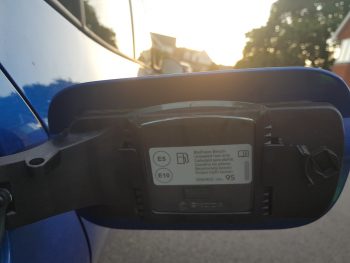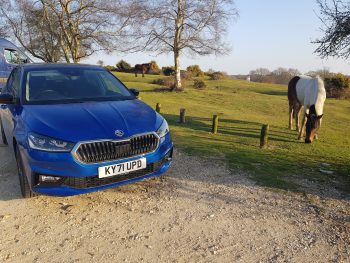Fleet World Fleet: Škoda Fabia
Škoda’s Simply Clever features bring a nice surprise when it comes to refuelling our Fabia long-termer.

Škoda’s hidden and handy ice scraper is a firm favourite with many drivers
Model: Škoda Fabia Colour Edition 1.0 TSI 95PS
P11d as tested: £20,810 (30% BiK) MPG/CO2: 51.4-55.4mpg/116-125g/km Test mpg: 40.7mpg
Test 2
Škoda’s hidden and handy ice scraper is a firm favourite with many drivers
I don’t think many people normally look happy when refuelling their car – and certainly not at today’s prices. But anyone who saw me fill up the Škoda for the first time would have clocked a broad smile appear – purely when I saw the ice scraper behind the filler flap. Having a soft spot for the brand and not having driven one for a while, I’d already found some of the ‘Simply Clever’ features, including the iconic tucked-away umbrella and the ticket holder on the A-pillar but I do have a particular fondness for the classic ice scraper. Even if it’s unlikely to come in handy during our test period.
In total, there’s some 42 Simply Clever solutions in the latest Fabia, including debuts such as the wireless charging on our £600 Convenience Package and the USB-C socket on the rear-view mirror, part of our £655 Comfort Package Plus. It’s able to power, say, a dashcam, without the need for cables to hang down.
I’m particularly liking the ‘easy open’ cup holder, which sits between the front seats and accommodates different size cups. The fact that it’s removable was appreciated when my takeaway paper coffee cup for a Jubilee afternoon tea leaked everywhere.
I’m not so impressed by the use of USB-C ports in the front, rather than the usual USB-A, which has thrown me a bit and prompted the need for new cables to charge devices. I know many carmakers are gradually moving to USB-C as it enables higher data and power to flow through and there’s no chance of getting the socket the wrong side up and breaking anything. Wasn’t so great when we first realised that the kids’ tablets were low on charge during a long car journey.
Meanwhile, a quick perusal of the press pack has yielded the fact that the body lines on the front doors replicate the triangle of the Czech flag – I’d spotted the lines but not made any such connection. Always handy to know for impressing friends or a pub quiz.
There are also two different Simply Clever Packages as optional extras, adding in various boot storage features.
Talking of which, despite its class-leading space, the first thing I did was take the variable boot floor on our Comfort Package out as the need to frequently transport a disabled member of the family means I need all available boot space, despite the model’s impressive 380 litres.
I’m also putting the fuel consumption to the test. Going from an EV back to a petrol in the current climate could seem like a recipe for disaster but with the car’s 51.4-55.4 WLTP combined, it could be a lot worse. I’m getting around 33mpg on urban routes and currently averaging 40.7mpg but that’s dropped significantly due to a lot of air con usage in the last week and a predominant shift back to urban driving.
However, I’m easily getting fuel consumption into the 50s on mixed routes with not much effort to be honest and it’s made me wonder how some concerted hypermiling could drive this further…
The Škoda Fabia has joined our long-term test fleet

The Škoda Fabia has joined our long-term test fleet
Test 1
The Škoda Fabia has joined our long-term test fleet and taps into key trends among UK car buyers for petrol powertrains and superminis.
Launched at the end of 2021, it’s the fourth generation of Škoda’s supermini and the first to be built on the Volkswagen Group’s MQB-A0 platform – adopted by the Polo some three years ago and also used for the SEAT Ibiza and Audi A1.
It’s built up a reputation over the years as the “practical” and “sensible” one among its class. So even after having seen the reveal pics, I was pleased to spot some nice design touches in the flesh that jazz it up and make it stand out more – particularly for our Colour Edition model that’s targeted at buyers looking for customisation and gadgets. Highlights include the 16-inch black metallic-painted alloys and black roof, B-pillar and door mirrors. Sadly, there is no vRS variant but there is a sporty Monte Carlo version.
Ours also comes with an optional (£610) race blue metallic paint and a number of extra features (more details later) that push the OTR price to £21,055.
We’ve also opted for the 95hp 1.0-litre TSI petrol with five-speed manual only – it’s one of three petrol-powered engines that make up the full line-up at the moment and one down from the range-topping 110hp 1.0 TSI. The latter is the only one to come with a six-speed manual or DSG.
The new-gen Fabia certainly reinforces its focus on practicality. Thanks to the new platform, it’s quite a lot bigger – 111mm longer and almost 48mm wider – increasing onboard space. Boot capacity, which was already the largest in the segment, is up 50 litres to 380, rising to 1,190 litres with the rear seats folded. The Fabia also comes with 60/40 split folding rear seats.
It also debuts enhanced Simply Clever features – much loved among Škoda drivers – along with new infotainment and safety and assistance systems. Tested by Euro NCAP in late 2021, it earned a five-star rating, including an 85% rating for adult occupants and 81% for children.
Interestingly, Škoda has just announced today that it’s taken action on industry-wide supply chain issues by partially relocating cable harness production from Ukraine to the Czech Republic in close coordination with the affected suppliers. This enables production capacity to be doubled as well as greater flexibility in responding to potential supply bottlenecks – helping circumvent current issues and getting bums on seats faster.
All in all, it’s a model that we’re looking forwards to reporting back on imminently.












